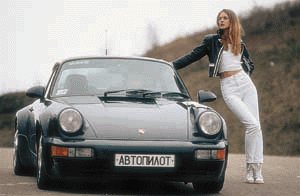Test drive Porsche 911 Carrera 996 1997 - 2001 coupe
Beast
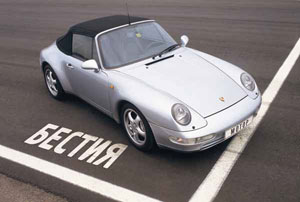 This model is a sign, embodied history of Porsche. The car is not just recognizable - nothing like it simply exists. Even at the dawn of its existence, the 911st has turned from just an excellent sports car into a subject of worship. Porsche 911 has always been contrasted with Ferrari machines - as one perfection to another, completely unlike it. But over 35 years, the range of medium and small Ferrari has completely renewed several times, and the 911th remained 911st. One way or another, since 1963, the world has been divided into fans of Ferrari and Porsche fans.
This model is a sign, embodied history of Porsche. The car is not just recognizable - nothing like it simply exists. Even at the dawn of its existence, the 911st has turned from just an excellent sports car into a subject of worship. Porsche 911 has always been contrasted with Ferrari machines - as one perfection to another, completely unlike it. But over 35 years, the range of medium and small Ferrari has completely renewed several times, and the 911th remained 911st. One way or another, since 1963, the world has been divided into fans of Ferrari and Porsche fans.  For 35 years, the form and content of the 911th became classics - the opposition six of the air cooling, packed in the overhang behind the rear axle, a body with a windshield falling from the rack to the rear bumper, and a bum -eyed headlight ...
For 35 years, the form and content of the 911th became classics - the opposition six of the air cooling, packed in the overhang behind the rear axle, a body with a windshield falling from the rack to the rear bumper, and a bum -eyed headlight ...  Even today, classic - with air - 911th does not look archaic. But this model is almost the same age as the cosmic era. The fundamental layout of its units, the roof and glass passed to it from the first Porsche 901 (with a 150-horsepower 2 liter of the engine), later renamed the 911th. Of course, by 1997 (the year of the debut of a completely new model - with an indicator of coolant temperature on the instrument panel) Porsche 911 has changed a lot - relative to the car, which was created by Porsche itself in the early 60s. But in essence, he remained the same Porsche 901 - except perhaps more powerful. The technical potential laid down in the 901 model was so great that it allowed her to hold out on the conveyor for 35 years without replacement! For mass sportsmen, this is an absolute record that other manufacturers cannot dream of.
Even today, classic - with air - 911th does not look archaic. But this model is almost the same age as the cosmic era. The fundamental layout of its units, the roof and glass passed to it from the first Porsche 901 (with a 150-horsepower 2 liter of the engine), later renamed the 911th. Of course, by 1997 (the year of the debut of a completely new model - with an indicator of coolant temperature on the instrument panel) Porsche 911 has changed a lot - relative to the car, which was created by Porsche itself in the early 60s. But in essence, he remained the same Porsche 901 - except perhaps more powerful. The technical potential laid down in the 901 model was so great that it allowed her to hold out on the conveyor for 35 years without replacement! For mass sportsmen, this is an absolute record that other manufacturers cannot dream of.  Paradoxically, it was the crisis that helped Porsche 911 survive to this day. The most difficult financial situation in which the company was located throughout the 80s, a lack of funds for the development of fundamentally new models and at the same time uncertain sales of a cheap 4-cylinder 944th and expensive 8-cylinder 928th led to the fact that by 1995 911- I became the only basic model of the company.
Paradoxically, it was the crisis that helped Porsche 911 survive to this day. The most difficult financial situation in which the company was located throughout the 80s, a lack of funds for the development of fundamentally new models and at the same time uncertain sales of a cheap 4-cylinder 944th and expensive 8-cylinder 928th led to the fact that by 1995 911- I became the only basic model of the company. There was one way out of this situation - constant modernization. As a result, the car was not only modernized, but reconstructed - and significantly. In 1983, an all -wheel drive (though racing) model was created, which a year later excited in Dakar; In 1986, a turbocharged version with a 3.3 -liter engine with a capacity of 300 hp appeared. and all-wheel drive Porsche 959 with 450-horsepower biturbo; A year later, a new version of Carrera with a 3.2 liter atmospheric engine of 230 horses; In the fall of 1988, Porsche Carrera 4 debuted with a drive for all wheels and 3.6 liters of a 250 hp engine. Modernization lasted until 1996. In 1991, Porsche received a fundamentally new posterior multi-link suspension, in 1992 the shape of wings, bumper, side body kit, headlights were changed ... This process could go further, do not accept the management of the company to replace this model with a fundamentally new .
No need to argue about which of the two Porsche 911 is better, especially which one is more real and correct: old or new. Both are good.
We had the opportunity to not get out of the old Carrera 4 within 208 minutes. All this time, the behavior of the machine on each meter of the trajectory has been carefully analyzed, but no rational explanation was found by Porsche and there was never. Of course, the racer Vasiliev will then lay everything on the shelves, but from this the car will not cease to be a mystery to me. As Porsche drives, no car drives ...
 Direct, speed 180, third gear, on a tachometer - 7000. Before turn - it is advisable to fit. Smoothly squeeze the clutch and at the same time knock on the brake: tuk-tuk, pull the second, throw the clutch. The machine seems to be compressed - like a spring. On the tachometer - again 7000! And ... a lightweight ruler! As soon as the clutch was squeezed out, the arrow rolled away to 5000. Again, catching the third gear and - to gas! Porsche shoots from a turn. After a second, I find the fourth and again Valya all the arrows of the devices. The speed is 210 ... three seconds have passed, no more.
Direct, speed 180, third gear, on a tachometer - 7000. Before turn - it is advisable to fit. Smoothly squeeze the clutch and at the same time knock on the brake: tuk-tuk, pull the second, throw the clutch. The machine seems to be compressed - like a spring. On the tachometer - again 7000! And ... a lightweight ruler! As soon as the clutch was squeezed out, the arrow rolled away to 5000. Again, catching the third gear and - to gas! Porsche shoots from a turn. After a second, I find the fourth and again Valya all the arrows of the devices. The speed is 210 ... three seconds have passed, no more. I undertake to say that the machine is absolutely predictable. You have no doubt about this for a moment - even when reactions on the steering wheel and in the chair cease to succumb to logical explanation. It seems to me that she, as a person, finds an optimal angle of attack on a turn and exit from him in her own way.
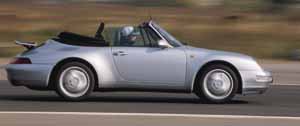 Porsche, as it were, plays with its axes, moving them from side to side at its discretion. At first you are trying to do something in order to neutralize the skins, then you get used to it and after 2-3 circles - as if you were doing this all your life - you famously put the car sideways into the turn ...
Porsche, as it were, plays with its axes, moving them from side to side at its discretion. At first you are trying to do something in order to neutralize the skins, then you get used to it and after 2-3 circles - as if you were doing this all your life - you famously put the car sideways into the turn ... I sat in a comfortable leather armchair and continued to iron the canvas of the road, signing in every bend with black oblique stripes - I enjoyed the attached understanding. And after an hour he no longer imagined himself outside this chair - torn from the hard suspension of this car and deprived of a 286 -horsepower engine that was supporting me ...
 I imagine how the computer works. But unable to figure out how the mechanical printing machine works! Already familiar, probably, with all electronic stabilization systems and fed with this acquaintance by the throat. But he could not understand how this gray beast could do this on the turns! Without electronics! Pure mechanics and gravity!
I imagine how the computer works. But unable to figure out how the mechanical printing machine works! Already familiar, probably, with all electronic stabilization systems and fed with this acquaintance by the throat. But he could not understand how this gray beast could do this on the turns! Without electronics! Pure mechanics and gravity!  I returned home (not to Porsche!), And it constantly seemed to me that it was not going - I tried to stick a third gear for 120 km/h ...
I returned home (not to Porsche!), And it constantly seemed to me that it was not going - I tried to stick a third gear for 120 km/h ... Office
 Alexey Vasiliev, Pilot team racer
Alexey Vasiliev, Pilot team racer Workplace of the driver
Planting is significantly higher than in other machines of this class. Large scales of devices. The tachometer dominates - and that is right.
Seat
Quite tough, with good lateral support. In the hips, support is more noticeable than in the back. This is reasonable - while driving you hold balance and posture mostly hips. There are no problems with adjustments to the pillow and back of the seat.
Review
Very good. Glass racks are almost invisible. Despite the fact that the car itself is low - there are no comments to visibility, due to the high landing. A good review is good for external mirrors.
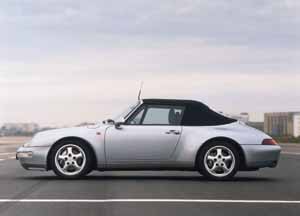 Steering wheel
Steering wheel The steering wheel is four -spoke, although for me - with obviously extreme driving - only two knitting needles would be optimal (this is more convenient for quick interception of hands). But this machine was created not only for extremely, and in all other cases (and most of them) such a steering wheel will be quite convenient.
Pedals
The pedals are conveniently spaced - the brake is closer to the gas, the clutch and brake are put forward to the driver, and the gas is located as if in the depths of the pedal unit. As a result, the right leg presses on the gas, constantly in a relaxed state. And this is very convenient with many hours of raids-after all, the 911st belongs to the GT class. At the same time, the pedals on Porsche are floor, the efforts on them are small. Gas pedal is generally weightless. The progression of the adhesion pedal is somewhat unusual (possibly just because it is flooring) - half the course of the course increases smoothly, then you feel a critical point when the clutch grip directly begins. At this moment, the pedal seems to rest and, pushing further, reports all the nuances of the clutch. Such informativeness is extremely rare and perfectly allows you to dispose of clutch, box and engine moment.
Transfer switching lever
The lever is located low, which allows the hand to work in a relaxed -eliminated position - this is convenient. The switching mechanism has large moves. This is probably done for a reason: the machine is charged with a very large moment and power, it is important not to confuse the programs - otherwise you will tear both the engine and the transmission. An informative switching mechanism, coupled with informative clutch, instantly grope and turn on the desired gear.
The overall impression of the salon
The design of the salon is perceived quite integral and does not look Spartan, as in the early Porsche 911. Nevertheless, it corresponds to the ideology of a sports car than luxury.
Suspension
Hard - another and cannot be on a sports car of this class. But at the same time, the increased suppleness of the silent blocks is felt - there is no rigid transition of strikes and lateral loads to the body of the machine. The suspension all the time plays along with the driver, imperceptibly eating irregularities, and at the same time retains excellent stability. This also affects the feeling of control of the car - when driving the rear wheels, a sharp breakdown does not occur immediately, before that you feel the gradually increasing suspension stress. So the skid can be controlled already at the initial stage, and if desired, it is neutralized - for example, gas discharge. In general, the suspension is comfortable.
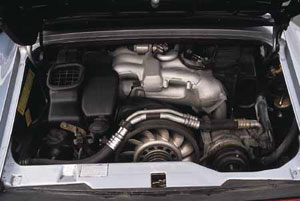 Engine
Engine Without comment, this is Porsche. And yet ... the engine twists over-well-beed in the entire speed range. There are no failures here and cannot be. During sports driving, you can bring down the tachometer arrow from 4 to 6.5 thousand, just have time to make programs. In normal mode, you can stay between two and five thousand, while you feel a big moment under the pedal: at any second it can be pressed and accelerated.
Transmission
Six programs. The long first and markedly close -closer five five. You can move smoothly and go for a long time only on the first, and then, by pressing the gas and working with a lever, to sharply inflame the pace.
Controllability
The car has insufficient rotation. The demolition of the front axle is noticeable (probably it can be somehow reduced by the optimal selection of tires). Manageability can be added with a rear with the rear - the moment of the engine only has this. These are purely sports techniques. But Porsche is good because it can be driven without these special skills - handling is acceptable for the average driver. It is a sin to complain.
 Dynamics
Dynamics Awesome ... In motion, on external factors - noise, vibrations - it is difficult to evaluate it. You can absolutely attend 180-200 km/h and at the same time be in complete confidence that you do not exceed hundreds. So it remains only on the speedometer. But, sitting down in Porsche, you don’t even think about his testimony - here you enjoy the speed as such. It is immediately clear that for this car and 250 is not the limit.
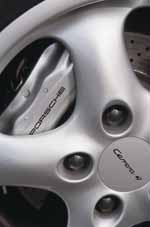 Brakes
Brakes Very good, smooth, with a pronounced progression of increased effort. Fully predictable. In addition, under the pedal, a very large supply of brake force is felt, which cannot be used completely even when braking at a speed of 200 km/h.
General impression of the car
You can only dream of this and hope that Luzhkov will build a lot of solid roads.
Yuri Tikhvin
Source: Motor magazine [No. 11/1998]






